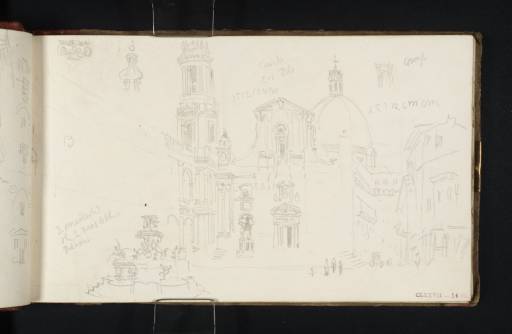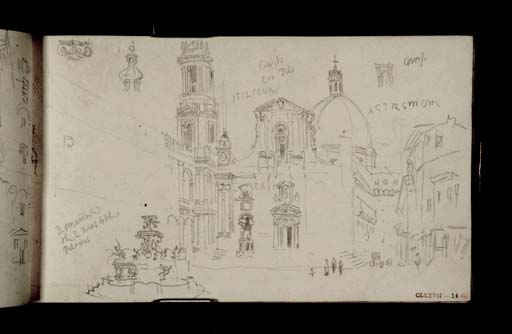Joseph Mallord William Turner Piazza della Madonna, Loreto, with the Santuario della Santa Casa 1819
Image 1 of 2
Joseph Mallord William Turner,
Piazza della Madonna, Loreto, with the Santuario della Santa Casa
1819
Joseph Mallord William Turner 1775–1851
Folio 14 Recto:
Piazza della Madonna, Loreto, with the Santuario della Santa Casa 1819
D14679
Turner Bequest CLXXVII 14
Turner Bequest CLXXVII 14
Pencil on white wove paper, 110 x 186 mm
Inscribed by the artist in pencil ‘13’ within left-hand side of sketch and ‘2 ornamented | the next 2 both | pilasters’ bottom left and ‘[?Canto cor Pili] | ITILICUM’ to right of sketch of bell-tower and ‘ASTRONOM’ to right of dome. Also ‘c[...]p’ top right
Inscribed by John Ruskin in red ink ‘14’ bottom right
Stamped in black ‘CLXXVII 14’ bottom right
Inscribed by the artist in pencil ‘13’ within left-hand side of sketch and ‘2 ornamented | the next 2 both | pilasters’ bottom left and ‘[?Canto cor Pili] | ITILICUM’ to right of sketch of bell-tower and ‘ASTRONOM’ to right of dome. Also ‘c[...]p’ top right
Inscribed by John Ruskin in red ink ‘14’ bottom right
Stamped in black ‘CLXXVII 14’ bottom right
Accepted by the nation as part of the Turner Bequest 1856
References
1909
A.J. Finberg, A Complete Inventory of the Drawings of the Turner Bequest, London 1909, vol.I, p.521 as ‘Chiesa della Casa Santa, Loreto’.
1982
Evelyn Joll and Martin Butlin, L’opera completa di Turner 1793–1829, Classici dell’arte, Milan 1982, p.[120] under no.331.
1984
Martin Butlin and Evelyn Joll, The Paintings of J.M.W. Turner, revised ed., New Haven and London 1984, p.185 under no.331.
1984
Cecilia Powell, ‘Turner on Classic Ground: His Visits to Central and Southern Italy and Related Paintings and Drawings’, unpublished Ph.D thesis, Courtauld Institute of Art, University of London 1984, pp.98, 408, 467 note 125, reproduced pl.30, as ‘Piazza della Madonna, Loreto, with the Santuario della Santa Casa’.
1987
Cecilia Powell, Turner in the South: Rome, Naples, Florence, New Haven and London 1987, [p.31], reproduced pl.26, as ‘Loreto: Piazza della Madonna’.
The first significant place of interest on the route to Rome from Ancona was Loreto, a famous site of Catholic pilgrimage. Turner made a large number of sketches in and around the city, see folio 10 (D14671). This page contains details and inscriptions from the historical heart of the city, the fifteenth-century basilica of the Santuario della Santa Casa which stands at the eastern end of a Renaissance square designed by Bramante, the Piazza della Madonna. Like many English tourists, Turner was fascinated by the Santuario and its most celebrated relic, the shrine of the Holy House. According to legend, the house was the home of the Virgin Mary which was transported from Palestine by a host of angels during the thirteenth century.
Here Turner has depicted the Renaissance façade of the Santuario from the south-west corner of the Piazza. The grand scale of the architecture is offset by the inclusion of three tiny figures at the bottom of the steps leading up to the façade. In the left-hand foreground is a fountain, built 1604–14, which stands in the centre of the square. Decorated with bronze dragons, this feature was designed by Carlo Maderno and Giovanni Fontana, the same architects who built the tunnels and aqueducts which supplied the town with water from Recanati. With typical economy Turner has drawn only a small detailed section of the building on the left, the north wing of the Palazzo Apostolico. He has then noted to himself that the remainder is comprised of ‘13’ two-storey arches. The height of the page has not allowed him to complete the adjacent bell-tower designed by Vanvitelli and instead he has added the top separately by the side.
The inscriptions on either side of the church dome come from the central cornice on the façade directly below the two clocks and relate to two different modes of telling the time. ‘ASTRONOM’ on the right, represents the European hour with the day divided by two sets of twelve hours. ‘ITALICUM’ on the left refers to the Italian hour where the clock shows just six hours with one pointer which indicated the amount of time left before sunset.
The view of the Piazza della Madonna continues on the opposite sheet of the double-page spread, see folio 13 verso (D14678).
Nicola Moorby
November 2008
How to cite
Nicola Moorby, ‘Piazza della Madonna, Loreto, with the Santuario della Santa Casa 1819 by Joseph Mallord William Turner’, catalogue entry, November 2008, in David Blayney Brown (ed.), J.M.W. Turner: Sketchbooks, Drawings and Watercolours, Tate Research Publication, December 2012, https://www


